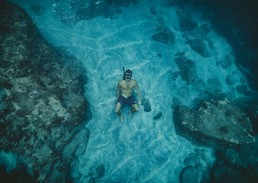Visiting Australia For The First Time
The Land Down Under holds a huge variety of sights and activities for tourists, ranging from its exotic fauna to the landscapes and seascapes that cannot be found anywhere else in the world. Travellers to Australia can see all the biggest sights in a matter of a week or two, but they should not be fooled by the continent’s small population. It is the size of the United States and is mostly sparse desert, so travelling by car or bus is not recommended. What’s more, it is far away and requires a flight that can be as much as a full day to get to the country.
Perhaps the greatest attraction in all of Australia is its coasts. As an island nation, you can find sandy beaches and plenty of fun water sports wherever you land. You can try many activities or just a few but without doubt; the most compelling is a snorkel trip to the Great Barrier Reef. This thousand-mile-long coral reef, visible from the moon, dominates eastern Australia’s coast. With more species of fish in a single reef than in the entire Caribbean, it is the diving experience of a lifetime. If you are trained to scuba dive, you can get even deeper to check out the fish, corals, and sea snakes. Go through ancient shipwrecks from ships that did not make it past the reefs. Marine animals like dolphins, whales, and sharks roam the reefs, so you can get a kick out of seeing the largest animals in the sea on patrol. Surf in the incredible waves of the Gold Coast and go on a horseback ride at sunset on Cable Beach. Once the day is done, eat the delicious seafood that thousands of restaurants across the country provide.
With dozens of natural parks across the country, visitors to Australia can see animals visible nowhere else on earth. The cute (but not always cuddly) koalas that roam the treetops pop down for a closer look while kangaroos hop around on legs that could kick down a door. The saltwater crocodiles grow larger in Australia than anywhere else except Egypt, while turtles and seals roam the shores in search of food. You can hike, bike, kayak, or go ATV’ing through the national parks in order to get your fill of adventure and sightseeing across the breadth of Australia.
What To Pack In Carry On
Packing your carry on can feel very high pressure as you do it, the choices that you make at home can dictate how comfortable and enjoyable your flight is. We’ve all made errors of judgement and packed things we didn’t need or forgotten those we did.
I’ve got a few fail-safe ways of remembering what I’ll need during the flight and prioritising what will get a coveted spot in the few kgs of baggage allowance that walk onto the plane with me;
- Be ruthless. There’s no room for packing ‘maybe’ items. Make sure what you’re bringing with you is something that you’ll actually use. I’ve learned not to bring my laptop on the plane anymore – I can watch TV on the seat screen and any reading/work I tell myself I’ll do on a flight I very rarely actually will. It’s a waste of weight and a waste of worrying about it getting thrown around too much! Wrap it in a good case and a jumper and keep it in your checked in luggage.
- Don’t overshoot it. Sometimes I think I need a dozen different thing to do on a flight, I get caught up in thinking it’s a super long time. Often times a long flight isn’t as long as you think, it gets broken up by sleeping and meals getting served. Once you’ve watched movie you’ll find you don’t need three books to read. Be conservative in how entertained you think you will need to be.
- R E L A X. Seriously. You don’t need to be busy on a flight. Sometimes we’re on the way to a holiday, and sometimes it’s for business. But when in the air it’s a perfect opportunity to take to relax. You’re unplugged, and you have a chance to not be a slave to your phone or the constant pull that everything gives for your attention.
Tips For Amateur Divers
We've gotten some question lately about how we first got into diving and how we choose places to dive now. The two are quite separate questions! So I'm going to deal with the first one now, and the second in another post. Getting into diving was a natural progression for us from snorkling any and everywhere we could. Here are 3 tips for how to make the progression into the bigs leagues!
- Get a buddy. I'm sure you can do this all by yourself, but it was super helpful having each other while getting certified and for moral support on the first few serious dives. Having someone else who's learning too I thought made me relax into the process more.
- Stay safe. Safety is huge even for the most experienced divers, but at the beginning it's especially important to er on the side of caution. You might feel you're a confident swimmer and generally capable in the water but when you throw you kit on and are trying to navigate all the things to keep an eye on that all goes out the window.
- Build your confidence slowly. Give yourself time and experience to help you get better. This will mean you're much safer in the water in the long run. It also means you'll enjoy yourself that much more. When you take the journey in stages you'll find that as your confidence grows and you can see and experience more you'll appreciate it all so much more.
Lastly, the ocean is incredible, and a lot of my best travel memories have been below the waterline. If you're interested in diving don't be putting it off any longer than you have to! It's the best decision to learn something new and get a new hobby that I've ever made.


